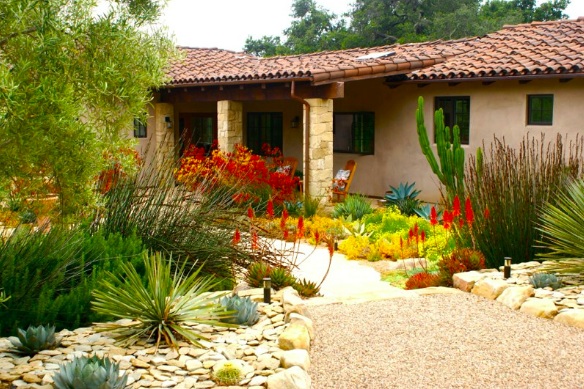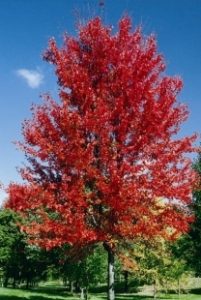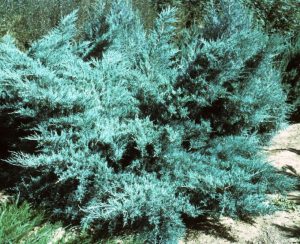 Our nice weather has triggered questions regarding ideas for improving or changing residential landscape designs. Landscapes are reflections of the individual homeowner, but they can lack that one-of-a-kind personality that denotes uniqueness. With a little help most landscapes designs could be outstanding. Here are the basics of design that could result in elevating the level of distinction in this spring’s landscapes.
Our nice weather has triggered questions regarding ideas for improving or changing residential landscape designs. Landscapes are reflections of the individual homeowner, but they can lack that one-of-a-kind personality that denotes uniqueness. With a little help most landscapes designs could be outstanding. Here are the basics of design that could result in elevating the level of distinction in this spring’s landscapes.
Better Landscapes #1 – Keep doors and windows uncluttered.
When plants have taken over the yard to the point that it is difficult to find your front door, you have a problem. An English ivy that suffocates the house, grapes that over take the deck, or trees that encroach the walkways may have a cottage feel, but they also restrict airflow. An overabundance of plants close to the house also encourages ant colonies and other insects to establish their homes near yours. If you can relate your landscape to any of these situations it’s time to prune and thin for a more habitable landscape. Don’t be afraid to do some major pruning; you plants will grow their way out of any mistakes.
A good residential landscape design should lead the eye to the main entrance. Security is another important reason for keeping entry points uncluttered. Burglars like foliage that keeps them hidden from view. However, when planted below windows prickly plants like roses, junipers, and pyracanthas contribute to security.
Better Landscapes #2 – Give your new plants space to grow.
Before buying, verify the size that each landscape plant will reach in the next 10 years. I’ve seen too many red-tipped photinia, with an ultimate size of 12 feet tall by 12 feet wide, planted next to the entry of a house. The plant is very pretty the first year, then as it grows it seems apt to engulf dogs and small children as it quickly reaches into walkways on its way to take over the rest of the yard!
Large trees should be planted well into the yard and at least 30 feet away from septic fields. Medium-sized trees are best placed at least 20 feet away from the house. Smaller trees like purple leaf plums, Japanese maples, and redbuds are rarely a problem close to the house. Adequate spacing also decreases potential for roots to grow up against foundations and cause structural problems.
Better Landscapes #3 – Plant for better home heating and cooling.
Proper placement of plants can greatly reduce your home heating and cooling costs. Deciduous trees are best planted on the southern exposure of your home. They shade structures during the heat of summer, but in autumn they shed their foliage allowing solar gains through winter.
 A good example of a cooling effect is the giant ‘Autumn Blaze’ maple shading our home’s front landscape. The temperature under the shaded area is often 10-15 degrees cooler than unshaded areas. Therefore, the water needs of plants in its shade are reduced because of the cool environment created by this large specimen.
A good example of a cooling effect is the giant ‘Autumn Blaze’ maple shading our home’s front landscape. The temperature under the shaded area is often 10-15 degrees cooler than unshaded areas. Therefore, the water needs of plants in its shade are reduced because of the cool environment created by this large specimen.
Large evergreens planted on the north side of a home reduce cold winter winds from creeping in around doors and windows. These plants also force cold wind patterns up, over, and around a home for a more comfortable cold season indoors. Several studies have found a 30% reduction in heating and cooling usage for homes with correctly placed large plants.
Better Landscapes #4 – Know your plants.
Walk your neighborhood to see the varying effects of different plants. Take a camera or other digital device (another use for that new iPad) while walking the dogs and snap a digital photo of the plants you like. Even if you don’t know the plants’ names you will have good quality photos of the plants that your local horticulturalist can use for identification.
Watch for size, shape, foliage, and flower colors that are appealing to you. A good landscape designer can use these photos as a reference point to suggest companion plants that grow well together.
~~ ~~ ~~ ~~ ~~ ~~ ~~
 Plant of the week is the Hetz Blue Juniper. Even during the coldest winters, this robust plant stands out with icy blue foliage that is almost impossible to kill. Mid-winter is when this variety really looks its best. Growing easily to 4 feet tall and twice the width it offers coverage of mountain hillsides and is hardy enough to be planted in rock lawns or beside driveways. This plant is winter tough, summer loving, easy maintenance, and a low water user in local landscapes. If you need a foolproof plant in your yard, plant this juniper now, plant it in summer, plant it anytime and enjoy years of its icy blue presence.
Plant of the week is the Hetz Blue Juniper. Even during the coldest winters, this robust plant stands out with icy blue foliage that is almost impossible to kill. Mid-winter is when this variety really looks its best. Growing easily to 4 feet tall and twice the width it offers coverage of mountain hillsides and is hardy enough to be planted in rock lawns or beside driveways. This plant is winter tough, summer loving, easy maintenance, and a low water user in local landscapes. If you need a foolproof plant in your yard, plant this juniper now, plant it in summer, plant it anytime and enjoy years of its icy blue presence.
~~ ~~ ~~ ~~ ~~ ~~ ~~
Gardening Class – Sedona landscape designer, Rich Olsen, has accepted an invitation to teach our January 25th class ‘Landscape Designs for Outstanding Mountain Styles’. Last spring Rich taught a similar landscape design class that was standing room only and got rave reviews. With decades of Arizona design experience his remodel ideas just feel right. The class is free, but coming early and bringing your own lawn chair is highly recommended. Class will be held in the back greenhouses at Watters Garden Center.
Until next week, I’ll see you in the garden center.


Recently moved to this area, love gardening and landscaping, got your website from search. Loved info from your site, look forward to roaming your nurseries and attending your classes.
Coming from zone 5,